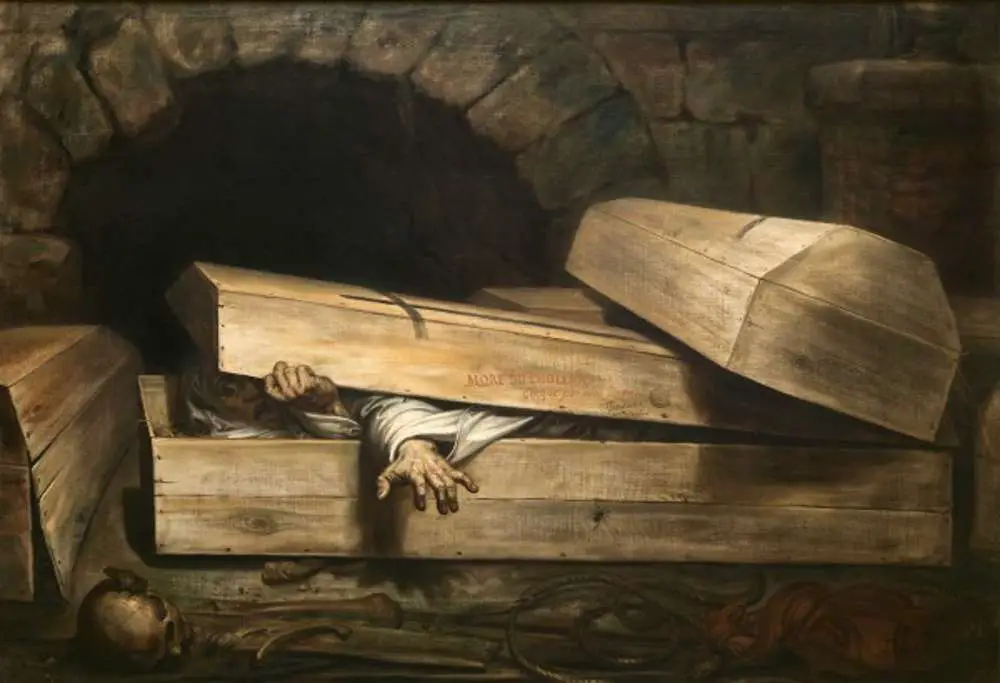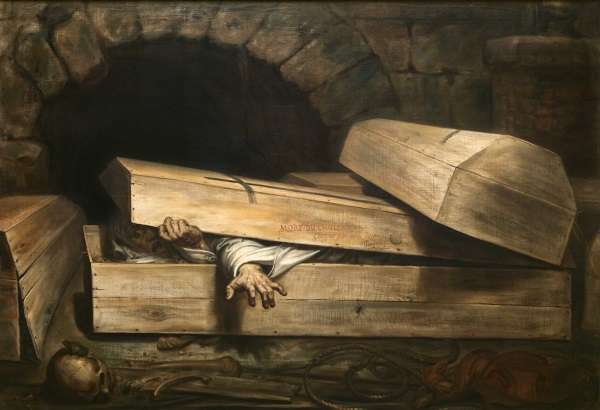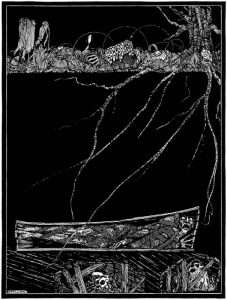George Washington famously feared premature burial. While on his deathbed in 1799, he instructed his personal secretary Tobias Lear to make sure he was dead before he was buried:
“Have me decently buried; and do not let my body be put into the vault in less than three days after I am dead.”
Washington ushered in an era of taphophobia, or fear of premature burial. During the 19th century, popular books and magazines promoted the idea that many people were buried alive. They reported tales of bloody shrouds, gnawed fingers and horribly contorted bodies inside their coffins.
During the 19th century a man named C.A. Read of Newton, Mass., left in his will $500 for his physician to cut off his head. The reason? To prevent the horror of a premature burial.
Premature Burial
During the 1800s, doctors had few ways to certify death short of waiting for a body to decay.
“Less than 150 years ago many medical practitioners freely admitted to being uncertain whether their patients were dead or alive,” wrote Jan Bondeson in Buried Alive: The Terrifying History of Our Most Primal Fear.
The fear of premature burial peaked in the mid-19th century, wrote Bondesen. It centered in Massachusetts and New Jersey. In Boston, publishers churned out books and stories of children restored to life after apparently drowning, women giving birth in their coffin and bodies exhumed with signs of struggle to escape their graves.
Edgar Allan Poe in 1844 took advantage of the raging taphophobia in the short story The Premature Burial. It dealt with a man terrified of being buried alive. Poe had such a hit on his hands he wrote four more stories about premature burial, including The Fall of the House of Usher and The Cask of Amontillado.
Moore Russell Fletcher
In 1884, a Cambridge, Mass., doctor named Moore Russell Fletcher fanned the flames of taphophobia. He authored a popular treatise on premature burial, One Thousand Persons Buried Alive By Their Best Friends. He based it on stories he collected from newspaper accounts around the world. Some described premature burial, others described premature preparations for burial.
In 1855, Fletcher wrote, the wife of Rev. Mr. Wells of Woodstock, N.H., seemed to die of consumption on a Friday. Her body was prepared for burial. “On the following Monday the lady revived an conversed freely with her friends; she told them that she was conscious and had heard all that was said about her, but was not able to speak or make the slightest motion.
Fletcher also reported that in June 1870, a Dr. Stroinski stopped at George Chandler’s house between Nashua, N.H., and Tyngsboro, Mass. His daughter Susan had died and was placed in a coffin for internment. The doctor examined the girl and declared she hadn’t died, but only fallen into a fit. He revived her and “the next day the girl voided a tapeworm of unusually large size.”
Then on March 13, 1875, a young man in Vassalboro, Maine, died of consumption. “Friendly hands prepared the poor, emaciated body for burial,” wrote Fletcher. But then, they “discovered that the heart had begun again to make its slow and measured beats, the pulse throbbed, the young man arose in his death-shroud, and spoke clearly and distinctly to those who stood appalled about him in the chamber.”
Safety Coffins
People began to invent devices to counter their possible premature burial. Inventors won patents for safety or security coffins.
One inventor won a patent for a safety coffin that allowed the buried person to move feathers or ring a bell to notify above-grounders of his premature burial. Another patented coffin featured an air tube and a signal device that sent up a red flag when hit with the head of the prematurely buried victim.
In New Haven, Vt., Timothy Clark Smith asked for a window installed above his gravesite, “six feet above him and centered squarely on his face.” He hoped someone would see him if he woke up in the grave. The window has clouded over, but since Clark died in 1893 it probably doesn’t matter.

A safety coffin employed a bell as a signaling device
In 1868, U.S. patent number 81,437 was issued for a security coffin. It included a ladder and a rope attached to a bell. If you woke up in your coffin, you could ring the bell. But if no one was around to dig you up, you could try to ascend from the grave via the ladder.
Still Here
The fear of premature burial is still with us. A safety coffin that allows the prematurely buried to ring a bell when they wake up received a U.S. patent in 2014.
Roger Corman based a movie called Premature Burial on the Poe short story in 1962. Then Hollywood released two films called Buried Alive in 1990 and 2007.
And taphophobia may have peaked well after Poe’s era. According to the Google Ngram, which measures how often phrases appear in books, ‘buried alive” peaked in 1952.
* * *
Available now in paperback. Get your copy from Amazon here.
This story was updated in 2023






1 comment
When I was a fifth grader the girl who sat behind me told me her grandmother was buried alive-I never was able to forget it-
Comments are closed.